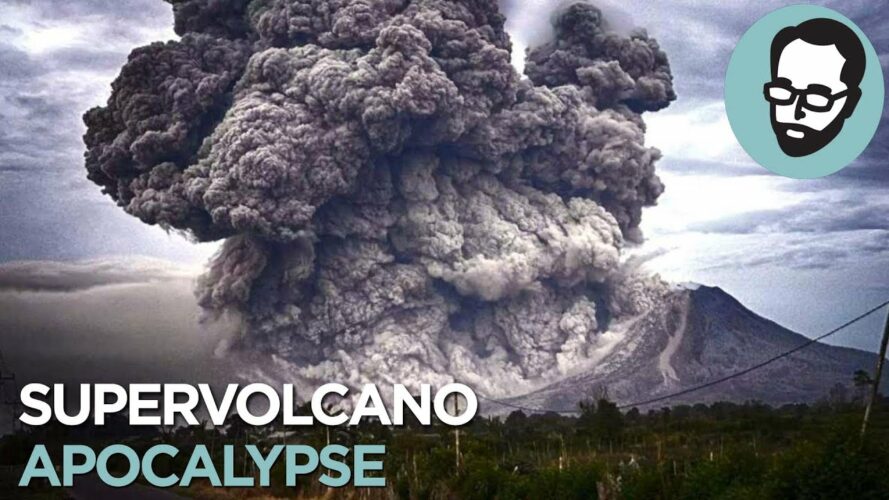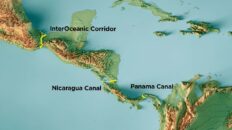Supervolcanoes are bigger than you think, and there are more of them than you think. There are, in fact, eight supervolcanoes around the world that have changed the geography of continents and caused mass extinctions. What are these volcanoes? What causes them, and most importantly, could we survive one?
Today we take a deep dive into one of the most destructive forces on the planet. And if you think that supervolcanoes have been over-hyped… trust me, they haven’t.
TRANSCRIPT:
The Minoans
3800 years ago on the Greek island of Crete, the Minoan civilization was one of the most powerful kingdoms of the bronze age.
In fact, Minoan culture was once so dominant that given a few hundred years, we might have been calling all of Greece Minoan.
But that’s not what happened. Instead, they disappeared from the region and from the historical record. So much so that we don’t really even know what they called themselves. The name “Minoan” refers to their ruler, King Minos.
And we only knew of King Minos in 1878, when his palace was discovered and excavated on Crete.
It was only after this discovery that more sites were discovered on Crete and nearby islands and we got an idea of just how extensive this civilization was.
What happened to the Minoans is still a bit of a mystery. But most agree it had something to do with this:
This is the Greek island of Thera, also known by its Latin name, Santorini. Today it’s one of the most popular travel destinations in the world, known for its distinctive architecture, dramatic 300 meter tall cliffs and stunning views of the Mediterranean.
But it didn’t always look like this. As you’ve probably already figured out, Thera is an active volcano. In fact it’s had minor eruptions 3 times in the last 100 years. But it was the eruption that occurred sometime between 1600 and 1700 BCE that reshaped not just the island of Thera, but the entire Mediterranean region.
It was an explosion that turned a giant mountain sticking out of the sea into this, a caldera, basically a sink hole.
This was basically a mountain that just blew up. Estimates say it exploded with a force of over 100 atomic bombs.
Recent estimates say the eruption could have ejected 60 cubic kilometers of rock and ash, with samples found up to 30 kilometers away.
Krakatoa, Tambora, and The Year Without a Summer
For comparison, the 1883 eruption of Krakatoa and the tsunami it created killed 36,000 people. Thera was 4-5 times more powerful than that one.
The tsunami from Thera would have devastated the Minoan’s coastal settlements on Crete and wiped out their navy.
Not to mention put enough ash and dust into the air to cause a global drop in temperature, much like the Tambora eruption in 1815.
This would have caused years of poor harvests and food shortages while the Minoans were still recovering from the damage done by the tsunami.
They didn’t vanish overnight, but they were weakened to the point that when conquerors from Mycenae came calling, the Minoans didn’t stand a chance.
They were crushed and within a few hundred years they were culturally assimilated, and then forgotten to time.
Not to mention the knock-on effects of the Thera explosion may have played a part in the entire collapse of the Bronze age around 1177 BCE.
The Thera explosion was truly epic in scale and influence, maybe one of the most consequential volcanic eruptions in the history of our species. And yet… When you set it next to the Yellowstone caldera, it looks like this.
(show pic)
Awe… That’s adorable.
Supervolcano Defined
This is the difference between a volcano and a supervolcano. You literally can’t see a supervolcano from the ground.
Yellowstone qualifies as a supervolcano because two of the eruptions that formed its calderas were supereruptions
To be a supereruption, a volcano has to eject 1,000 cubic kilometers (240 cubic miles) of material into the air.
Would a thousand kilometers be a megameter? Megometer? It would be a megameter, right? How come I’ve never heard of a megameter? Is that a thing?
You know, arguably the most consequential volcanic eruption in human history.
According to Jake Lowenstern of the U.S. Geological Survey, Yellowstone’s supereruptions ejected “enough material to bury the state of Texas five feet deep!”
When I read his
quote on yellowstone.org, I couldn’t tell if he meant both supereruptions together or each separately and it turns out no, each eruption could have buried the entire state of Texas.
Eruptions are rated on the Volcanic Explosivity Index, or the VEI and supereruptions rate as a VEI Magnitude 8, or M8.
The ancient Thera and Tambora 1815 eruptions — both of which lowered global temperatures, remember — were rated an M7.
Which sounds pretty close, but the
VEI Index is logarithmic, so Thera and Tambora were only one-tenth of the way to a supervolcano.
Luckily for us no supereruptions have occurred since prehistoric times. But… Yellowstone isn’t alone. There are several supervolcanoes around the world just waiting to end that streak.
So how bad would it be when – not if – that happened?
No Easy Answers
To answer that question, it might be helpful to know why supereruptions happen. And the short answer is — there are a lot of long answers.
Volcanology is a field of study that’s constantly shifting and eroding.
That’s a metaphor!
So most volcanic activity happens along
tectonic plate boundaries. It’s the cracks in the pie crust where the filling oozes through. I’m a little hungry.
Thing is, not not all volcanoes are born at the edge of a tectonic plate. Some, like Yellowstone, form right in the middle.
So one theory involves so-called “hot spots” the Earth’s mantle. Also known as Large Igneous Provinces.
Hot spots melt rock into magma, which then oozes out or erupts. Makes sense, but what causes the
hot spots?
Mantle Plume Theory
According to geophysicist W. Jason Morgan, they’re caused by mantle plumes.
In 1971, Morgan proposed that these plumes originate deep in the Earth as a bubble of hot material.
Like I wear this shirt a lot and this is how we normally see the layers of the Earth displayed but of course it’s not perfectly symmetrical and round, it’s loaded with bulges and mantle plumes. It’s got curves yo.
But that’s mantle plume theory, the Earth is a giant lava lamp and hot bubbles of magma rise through the crust, melting rock along the way, and the heat pressure builds up and explodes in a giant supereruption.
Plate Theory
The problem is, not all scientists are convinced mantle plumes exist.
This states that movements of the plates cause changes in pressure far from the plate boundary.
So if local mantle rock is close to its melting point, depressurization can heat it to a magma state.
Felsic Magma
What happens next depends on several conditions, one being the composition of the magma.
What it does instead is it builds up in large pockets, melting the rock around it, releasing gasses that build up pressure until there’s nowhere for it to go and then Boom.
What makes a supervolcano “super” is the amount of energy in its eruption. No matter where the magma comes from, supervolcanoes have much larger chambers to hold the flaming death they must hurl at the sky.
Over the past 36 million years, there have been something like 42 supereruptions.
That number varies because figuring the VEI of ancient eruptions is tricky, but let’s take a look at some of the best known supervolcanoes.
Yellowstone
Let’s just start with Yellowstone, because I was already talking about it earlier and like I said, it’s had a couple of supereruptions.
The biggest one was the Huckleberry Ridge Supereruption that formed the largest portion of the caldera 2.1 million years ago. The second one called Lava Creek, extended the caldera’s Eastern boundary some 640,000 years ago.
Both of these supereruptions ejected enough ash to cover most of what is now the Western United States.
The US Geological Survey classifies these as “relatively nonexplosive”
“Relatively” is the key word here, apparently some were the size of the Mount Pinatubo eruption in 1991 that killed 847 people and destroyed 37,000 acres of forests.
Thankfully nothing so destructive has been seen at Yellowstone in tens of thousands of years. In fact the last volcanic event there was 70,000 years ago.
La Garita Caldera and Wah Wah Springs
But Yellowstone isn’t the only supervolcano in North America, actually there’s… a surprising number of them.
This includes that La Garita Caldera in Colorado and Utah’s Wah Wah Springs Caldera which happened just two million years apart — a drop in the bucket in geologic time.
By the way, Wah Wah Springs may be a funny name, but it was a monster eruption, it’s estimated to have ejected 5500 cubic kilometers of debris.
Aside from the asteroid that killed the dinosaurs, the Wah Wah Springs supereruption may be the most energetic single event to happen on Earth.
Flat Landing Brook Formation
And believe it or not, even that might be beaten by another supervolcano in North America called the Flat Landing Brook Formation in Canada.
I say might because it happened so long ago it’s hard to tell if it happened in a single event or over multiple supereruptions.
All we know is that 460 million years ago, this formation deposited 12,000 cubic kilometers of material over the area.
It’s assumed this was an ongoing process over millions of years but if it did happen all at once and ejected more than 10,000 km-cubed, it would break the Volcanic Explosivity Index.
M8 is supposed to be the upper limit, but ten-times an M8 should be an M9, a magnitude that’s off the chart
Mount Toba
Finally stepping out of North America, Mount Toba in Indonesia is another supereruption that could break the scale.
Anyway, it’s ejecta has been given a range between 1500 to 13,000 cubic kilometers, which would would dwarf Wah Wah Springs on the high end.
Lake Taupo
Then there’s Lake Taupo (Toe-paw) in New Zealand, whose supereruption named
Oruanui turned Mount Taupo into Lake Taupo about 26,500 years ago.
This wasn’t the largest supereruption on record but it was the most recent, and it has some interesting features.
For one thing, it happened in stages, with long breaks between. Most supervolcanoes don’t work like this but it’s thought that it may have been drawing magma from another pocket along the Kaiapo fault.
Over those phases it ejected 1170 cubic kilometers. Again, that’s on the low end for supervolcanoes but it was still strong enough to cover islands 1000 kilometers away in
18 centimeters of ash.So even if you’re a megameter away, you can still get dusty.
On top of all these supervolcanoes I mentioned there’s also a couple in South America, including the Cerro Gaucha in Bolivia and the Andes Central Volcanic Zone in Chile.
Interestingly, more than half of all the supervolcano eruptions around the world have been in North America.
Mass Extinction
That makes for a grand total of 8 supervolcano sites around the world. And none of them have gone off in a while. (nervous) Which is a little unsettling.
But exactly how borked would we be if one of these bad boys blew its top? Would it be an extinction-level event? Looking back through history can give us a clue.
Because the largest mass extinction on record is thought to coincide with a series of volcanic events.
Assuming, of course, you don’t count the current anthropocene extinction event we’re currently seeing right now, in which the volcano… is us. Be the volcano.
The Permian-Triassic extinction event, dated to around 252 million years ago, took place at the same time as the formation of the Emeishan Traps in China and Russia’s Siberian Traps.
These “flood basalt provinces” were shaped by tens-of-thousands to a million of years of eruptions and lava flows that also released
massive amounts of carbon dioxide, which changed the climate drastically. And killed 96% of marine species and 73% of terrestrial species.
Again, this took place over a length of time longer than our species has been in existence. A single supervolcano explosion probably wouldn’t be enough to totally wipe us out.
But… it wouldn’t be great either.
First of all there would be massive devastation anywhere near the supereruption site. Remember that a Yellowstone eruption could bury an area the size of Texas under 5 feet of ash and magma.
So you can pretty much expect the western half of the United States to be uninhabitable for a while. That alone would displace or kill between 100 and 120 million people.
The atmospheric problems would probably clear up relatively quickly, in a year or two. But if the Minoans taught us anything, it’s that nature is only one part of the equation. The rest is societal.
Because society will absolutely collapse. And here’s how you can prepare for that.
Worst Case Scenario
First of all, stock up on toilet paper. Because we’ve all seen how fast that can disappear.
You’ll also want to stock up on shelf-stable food, any medicine you need, and supplementary vitamins
Gas masks are essential if you’re anywhere near the eruption because not only do they release toxic gasses but also a lot of CO2.
And once you’re done hiding from gas clouds, you’ll be ready to hide from a much bigger danger. Your neighbors.
When the food starts going away, people get a little crazy. We saw some of this in 1816 after the Tambora explosion and crops started failing.
Hell just the several days of darkness as the ash spreads around the world would make some people go a little primal.
So it wouldn’t be the worst idea to have an underground bunker with an electric generator, because electricity infrastructure would be massively damaged and plants will start going offline.
Of course the generators would only last a little while. Chances are transportation corridors would be closed, so gas will eventually run out when trucks can’t get to the stations.
So you’ll want to have some source of localized power. Solar is good but limited as the ash has darkened the sky, so having some wind power would help out a lot.
Just be ready to defend that when the angry hoardes come calling.
In fact, some speculate that we can expect to see communities springing up around nuclear power plants because they would still be making energy for a long time after the eruption.
Humanity would recover eventually. Maybe with our current level of technology, we would have the ability to get back up to speed faster than the Minoans were able.
Luckily, all of these sites and large igneous provinces are being studied obsessively and nobody thinks there’s a threat of a supereruption happening anytime soon.
And even then only the worst of the worst case scenarios would end our species. But it’s possible. Maybe even inevitable.
And there are other threats besides volcanoes, asteroids and the like that threaten our planet; this is the reason many people argue that we should colonize the solar system.
Don’t put all your eggs in a basket filled with supervolcanoes.
We live on a dynamic and volatile planet. One guided by forces that we can’t control. Supervolcanoes are a sobering reminder of that.
But, and I can’t repeat this too much, it could be thousands of years before another supervolcano goes off, and there are other threats that are a lot more immediate. So let’s focus on those.




Add comment